What is a Russian baroque and what it differs from European. Biography of the style, characteristics of the main directions, workshops.
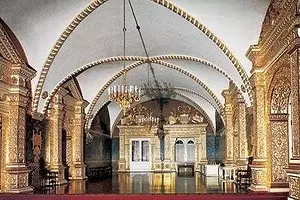
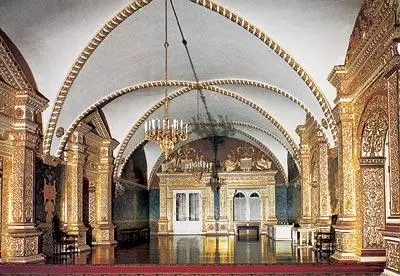
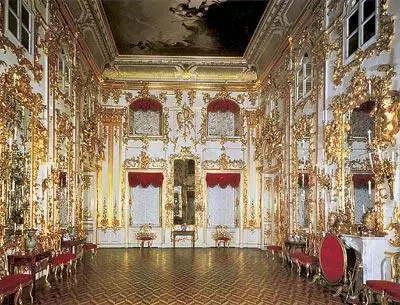
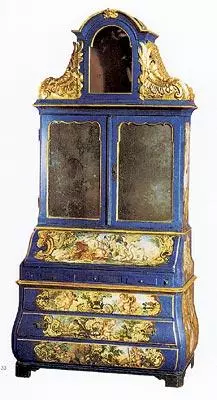
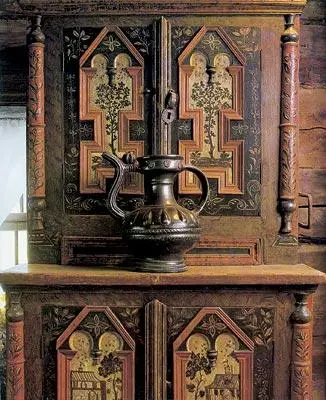
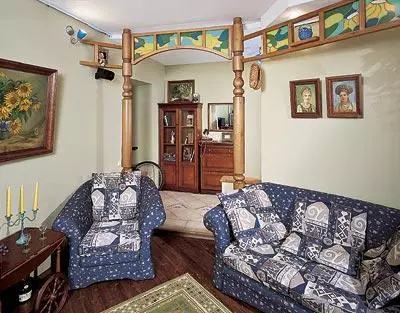
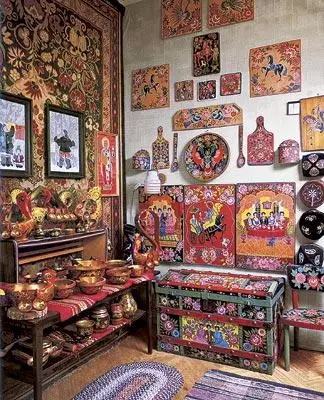
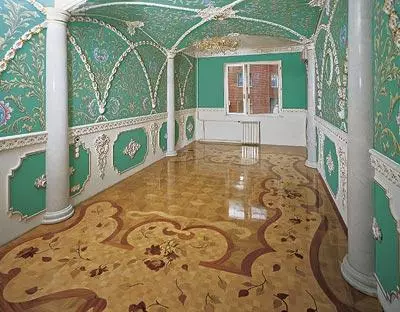
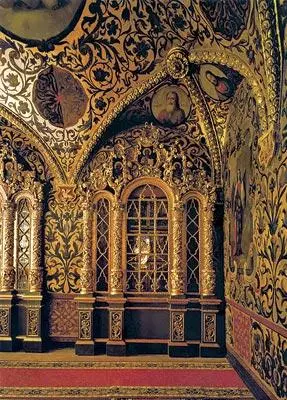
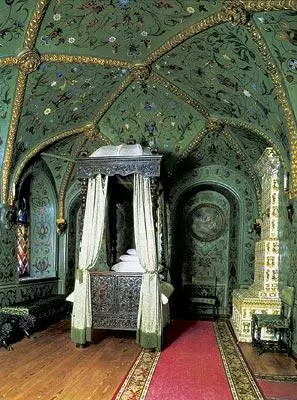
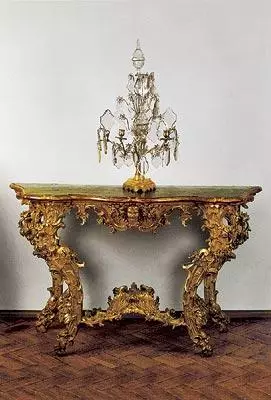
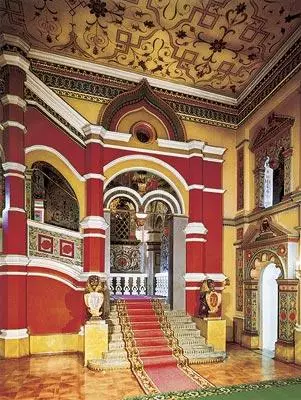
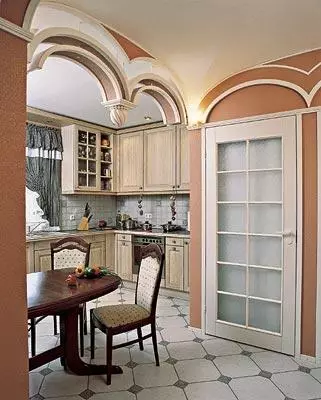
Three hundred years among Russian snow bloom lush golden curls, which baroque fantasy in excess gives different interiors, from the palace to the house, from the house to the apartment - turning them into a kind of "paradise Kusch"
Style appearance in Russia
Baroque style perfectly accustomed not only on Western European, but also on Russian soil. Reproduced in a tree and stone, it has become a symbol of luxury and pomp, redundancy and excessiveness.Symphony of a baroque abundance (or at least some of its notes) sounds in our interiors for three centuries. Moreover, style fragments can manifest itself at all levels of the social staircase and at all levels of taste - and in the palaces, and in the huts. So, the souvenir-painted Khokhloma with gold colors and a restrained-blue Gzhel were, in fact, options for naive popular imitation of the magnificent "palace", but cheap materials. Bright flowers on peasant headscarves and sweaters also captured simplified, but direct popular understanding of Baroque. So, what is the Russian baroque and what did it differ from, say, Italian? First, it is still the reflected light of the "distant European star" of the original source, imaginable happiness of some beautiful and prosperous land. Moreover, a repeatedly rethought European sample has changed so much that it is time to talk about the original and quite independent phenomenon of the Russian baroque.
As already mentioned above, the atmosphere of Baroque in his national understanding was impregnated, starting with SXVIIIVEK, all layers of society - from the aristocracy to the peasants. General for such different style manifestations were, firstly, the feeling of form, secondly, decorative plastic and, thirdly, color feeling. At all levels, there were three main fine-expressive components: asymmetry, contrasts, large volumes, from the sophisticated professional to the spontaneous-national-varnachitecture and the inner decoration of the houses: asymmetry, contrasts, large volumes. Everywhere and in the furniture, and in the interior decoration, we see the abundance of decor, flowable and at the same time dynamic shapes, plastic lines. Equally important for the domestic style of the style of the brightness of the color stain. Asymmetric details of the decor or structural elements served to transmit traffic.
The Russian Baroque end of the XVIII and the first XVIII and the first large European style, easily and organically fit into our national tradition. At the same time, it was the time of the first large-scale invasion of European culture in Russian life.
Biography style
For detailed familiarization with Russian Baroque makes sense to divide it into three main directions:
one. "Church" Baroque.
2. The "palace" baroque is the brightest and typical.
3. "Elementary", "People's", Baroque, latest.
"Church" Baroque
His motives appeared in the decoration of Russian churches still in the XVIIVEK, and then developed in secular construction and design. The famous Naryshkin baroque was colorful, bright, juicy in color and alive in lines and plastic. Probably you can call it optimistic. The connection of the Naryshkin Baroque with a folk tradition speaks of his common roots with the "Russian style".In the architecture and internal decoration of the Russian churches of the XVIIV, the touching Russian sentimentality affected the fact that historians call secular influence. Instead of domes, preference is given to elegant decorative lumps or vases, instead of simple planes or curly painting-abstract ornaments, roses and "grapetes". A characteristic example of the early Moscow Baroque can serve as the famous bell tower of the Menshikova Tower. There is an abundance of decor, even what is called, "with a bust in", and golden bumps, and the bright red color of the most buildings. Once the bell tower was the last fashionable fashion, a kind of Moscow skyscraper, and even the overseas dick in the sense of construction equipment and appearance.
Early baroque buildings in Russia necessarily painted in red or blue, thus also highlighting among others, not baroque buildings. Inside the churches, formerly modest, reflecting the religious worldview, there were magnificent, mainly carved iconostasis with twisted columns, with cushioned floral ornaments, roses, garlands. The iconostasis seemed to be switched to the category of spectacles of Paradise and abundance, constituting a striking contrast to black curly peasant sinks. Already at the end of the 18th century, gold-plated frames and carving of iconostasis, platforms, openings and royal gates began to meet in churches. The "gingerbread" appearance of the Russian "church" baroque is easily and naturally combined with modern construction technologies. Later in St. Petersburg, the Church acquire the European appearance.
"Palace" Baroque, or "Palace Style"
At the end of the XVIIV century in Boyarskoy, for the first time, the division of residential space on the functions - on the premises, in which they sleep, accept guests of IT.D. Before the era of Peteri, even in the Kremlin was not, say, the meals or receptions. If necessary, holiday tables were placed in a grain or weapon ward. Great and non-religious princes could take caregivers and overseas ambassadors, even in crowds, midstairs on the perins and pillows, covering the foxes from the cold. The division of the house on, as we now speak, the functional zones occurred in two principles: the Lord's premises and premises for servants; on female and male halves. Residentials in Boyar Teremes were built in many respects by the rules common with peasant hollows. For example, low ceilings and low door perts dictated by the considerations of heat saving. Through the palaces, in the boyars and noble houses, the tradition of embedded furniture retained the tradition of embedded furniture. So the cost-effective version of the organization of the interior, the newly included in the end of the XXVEK, was known for our ancestors three hundred years ago and was widely used.
For the first time at the beginning of the XVIIIV, architects begin to design an internal design of the building at the same time as an external, that is, emphasize the relationship between the external and internal appearance, conforming to the concepts of convenience and beauty.
In Peter, the first, most modest version of the National Baroque was born in Russia. He was close at the same time both to a folk style of style, and to North European (accomplice, Dutch). The love of Peter's love is known to the Germans, and they differed from the French and Italians just the restraint of the design of life. Petra's house in Kolomenskoye is essentially wooden hut with low ceilings and small doorways. Communication with folk style variations manifested itself in the decor and carving furniture, let's say in the painted inserts and decorating the bed. Prosles used popular vases and imperious garlands.
Incomparably fashionable and elementary, one of the later residences Petra-Palace Montplasir in Peterhof. The palace is designed and built by the architect Brantstein in Dutch style. The walls are decorated with oak panels, picturesque canvas of Dutch and Flemish artists, lacquered paintings. The rooms, in the spirit of time, are decorated in the style of "Shinoazri" - painted by miniatures on Chinese themes and covered with varnish. The pure baroque motif was a combination of black lacquer with a sophisticated gilded carving and bright red trim panels. The so-called barmer chairs, soft and deep, appear to accommodate.
Elizabethan Baroque can be called the highest point of style in Russia. As if the bright golden sun rose over the harsh snow-covered fields and forests of our homeland. The image of "Golden Paradise" was embodied in the construction of the Catherine Palace in the royal village, named after the wife of Peter Empress Catherine. For the implementation of the plan, the Great Rastrelli was invited. That was a kind of top of the "palace" style. Preparation halls The amount of gilding reached the "critical mass" - the architect achieved a unique impression: the real plane was dissolved, disappeared in a solemn and intricate gloss of reflected light. In other words, the final destruction of the plane was accomplished, the decor became self-concrete.
Gilding has always been close to our national color perception. Strictly speaking, the golden color is so beloved by our ancestors was not a color, but a symbol of some "proved", "paradise" light. It is the light, and not a color to see a man in a shining brilliance of gold-plated iconostasis, "gold" icon backgrounds and clothes of the Virgin. Also, it was organically the image of "Golden" was moved to the palace rest of Empress Elizabeth.
The space was revived due to the dynamics of the lines, they now became more winding, bizarre. Parade halls intended for balls and "Mashkeradov" were made, however, with an obvious disregard for the "features of the national climate." Too large, a few hundred square meters, with high ceilings and huge windows, they never hit well enough and always blurred with ruthless drafts. The inner space of the frontal baroque hall was rather decorative than functional. Stay in it did not differ in great comfort. If you remember the humorous poems of Count A. Tolstoy, "Merry Queen was Eleisteve. Sings and having fun, there is no order for now!" The order and the truth was not too much. Say, the furniture headset in a modern understanding did not exist, in the same room there were different objects of the situation, distinct tables and chairs. Instruments were produced only to the furniture for the seating, where canapes and several chairs were included. Armchairs in the era of Elizabethan Baroque did wide, with the seats of trapezoidal shape, very suitable for immense ladies' front dresses with fithma.
The art of the furniture decor included gilding on Levukas, relief threads, plywood, painting with plot compositions. Landbilling of furniture was also often used by a very refined technique of inverting the alternation of bright and dark parts of the image and the background of the same drawing.
Chamber residential chambers were furnished much more diverse. Here appeared fundamentally new, unknown leisure items: Geridon tables (stands for adorable baubles); Tables - "Bobbs" who received their name thanks to the tabletop in the form of Bob; Tables for needlework; Famous and understood Liver tables designed to play cards. Forming confidently included lacquer furniture. Wavy lines and bent legs attached to the subject expressiveness and at the same time a shade of some frivolity. It was laid in the mood of the era, so loved festival, balls and fireworks
.One way or another, the real space turned the efforts of decorators into fiction fictional gardens and mythical parks, where they were lack of flaky nymphs and goddesses. If in the era of the great father of Elizabeth murals, upholstery fabrics, tapestry and trellis dominated plotless ornamental compositions, but now there was the fashion for "instructive and entertaining image of the Greek Roman gishtorii Ali."
"People's" baroque
On the one hand, we will take it to this phenomenon the spreeless desire for redundancy, which manifested in the abundance of colorful paintings and a variety of threads in the peasant sinks. Everything is explained quite simple: a person needs a holiday in everyday life. This daily holiday need the Baroque style is most fully responsible. The other party of the "folk" baroque was naive reflection in the peasant and merchant life of the palace manifestations of high style.Baroque in the usual folk perception was a sign of top prosperity. Almost every person, just who achieved weakness and seeking his visual expression, sought by Ktaka aesthetics. Baroque offers us exactly ideal wealth images and is largely identical to them. From here a favorite style symbols of prosperity and a lot of gilding. Paintings, ornaments, sculptural decoration amazing abundance of flowers and exotic fruits, which in Russia he has never grown - grapes, pineapples ... If we are to "submit to the Arts" heavenly abundance and extravagance, is not the same with apples in the garden turnips portray!
The image of the paradise wealth is simple and at the same time intricately appears in bright ornaments and applied peasant art. Vomnogom national thrust to the visible, substantive welfare explains the popularity of the Baroque to the present, when after the Soviet austerity we have entered an era of plenty of expensive things, previously inaccessible. A similar phenomenon was observed under Petrovsky reforms. Then, after relative isolation, Russia also plunged into the redundancy of the European culture of the beginning of the XVIIIV.
Modern interior design mainly prefers the "Palace Style" "People's" Baroque. Even the recent Soviet fashion for the decoration of urban apartments with details of the pseudochetian life was elected in preferences. The intelligentsia of the 60-70s chose for its urban interiors not strawberries and curros, and the icons are more precisely and perhaps, not even from the folk, but from church life. The Manege Square with its brutal animals and a magnificent decor and a monument to Petrui to Zurab Tsereteli is also nothing more than Baroque, but in its mass version.
Workshop
For today's practical lesson, you will choose the following decorative techniques suitable for "embedding" in a modern interior:
but) S-shaped line
in) curls
from) Carts,
d) Garlands.
Our task is strictly decorative, feel, feel the style in the interior. To do this, you can take any ornamental fragment of baroque paintings and reproduce it in your home. Thus, the goal we is pursued is not to design a baroque interior in all its purity, and the creation of a baroque atmosphere, immersion in the style of style, control the measure of the presence of this style in modern dynamic life.
One of the main tasks as a decorator will be the so-called destruction of the plane. Baroque does not happen little. Remember that it, in contrast, let's say, from modern or minimalism, does not require complete submission to the details with the overall plan. Therefore, one-two expressive elements are enough to create a baroque atmosphere.
The first step on the way of decorating - mastering the main plastic motifs of the style. Combining the simplest elements - s-shaped lines, garlands, cartouches, curls, you can achieve all the effects of baroque puffs. They are simple and expressive at the same time.
Choose a suitable surface for painting. The most secure in terms of invasion of the established interior will create small desundests over doorways. First, as usual, make a sketch in a pencil, then repeat it in color. Already at this stage, it is necessary to envisage that the fragment of the style of colorful and placifically fit into your not necessarily a baroque interior. Then we carry out cardboard, increase the sketches to the real size of the future painting. Cardboard split into cells. Now the wall can be applied to the wall. Then the wall fragment is broken into the cells, which you are going to paint. Cells include as follows: Vertical letters, horizontally digits. Transfer your baroque curls, Cartignes and Ormushly on the wall to the cells. The painting is better to perform water-level paint, which is without fear possible in drying to cover with varnish. Such a technology makes the process reversible- if something did not like it, the surface can be painted and repeated everything again. The water-emulsion paint allows you to fix individual fragments, and the entire painting is entirely.
The image of the figures of people will require certain artistic training. If you are not sure of your professionalism, limit the garlands, flowers, vases. The painting on the wallpaper is better to avoid, because the paint can pull them and lead to extremely unpleasant warming. Baroque curly shapes flowable, smooth, without squares and rectangles. Vignettes, scrolls, curls are familiar to us since the school notebooks packed during boring lessons. It remains to remember these bizarre lines and make accents of gilding, important decorative moments of style. Baroque style is essentially bright. Relaxed color, do not spare the aerosol bronze. Create an appropriate image in a modern interior is also possible with the help of a home collection. For example, the people in which icons are presented, painting in lush frames, Khokhloma, Gorodetskaya painting IT.D.
Since our goal is not to recreate the style, but only a slight reminder of him, try to concentrate significant elements in one place, say on the same table, on one wall. Praphrasing the famous joke, it can be said that Baroque, as a good person, should be a lot. Avoid white smooth walls and neutral surfaces. They are better to drip drapery, tighten with Russian colorful scarves.
Russian-Designer Phrasebook
Avanzal - (SPR. Avant- Front part) - room before the main hall in the palace.
Allegory (Cut. Allegoria) is an expression of an idea or concept of allegorically, in art images.
Alcove (SPR. Alcove) - Niche, separated from the main space room with a curtain, arch or columns.
Canopy (Deletes. Baldacinus - Dear Silk Fabric from Baghdad) - Drape or imitating its decoration above the lie or throne.
Geeridon (SPR. Gueridon) - table or decorative stand on the leg-column.
Garland - pattern or ornament of flowers, ribbons, leaves, fruit woven in the form of a chain.
Desundport (SPR. Dessus de Porte- above the door) - decorative panels above the door or window opening. As a rule, the desundests had bizarre outlines.
Jardinerka - Programmer art, stand, shelf or basket for indoor or balcony colors.
Cabriole (SPR. Cabriotok and Cabriole-jump) - Gracefully curved furniture legs, sometimes ending with images of the animal paws. Very characteristic shape for baroque and rococo.
Canape (SPR. Canape) - a small sofa with a raised headboard, as if composed of several chairs.
Cartouche - stucco or graphic decoration in the form not to the end of the deployed scroll or leaf with curls. Cartuchs were placed inscriptions, coat of arms, emblems.
Ormushl (Taken. Ohrmuschel - Own sink) - a baroque ornament combining the Cartus with interlacing and grotesque.
Paduga - Winterrier Baroque and Rococo-curved concave surface, drawing up from the vertical wall to the ceiling, to the ceiling.
